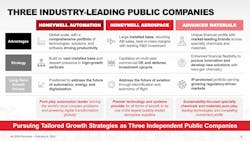Honeywell plans to follow General Electric down the de-conglomeration path, splitting itself into three separate companies.
The industrial giant has slowly been splitting itself apart for more than a year, selling its personal protection equipment (PPE) division for $1.3 billion and announcing plans to spin its advanced materials business into a standalone company. On Thursday, Chairman and CEO Vimal Kapur announced the next step in that strategy, split off the company’s aerospace and industrial automation units.
“Honeywell Automation will create the buildings and industrial infrastructure of the future, leveraging process technology, software and AI-enabled, autonomous solutions to drive the next generation of productivity, sustainability and safety,” Kapur said. He later added, “As Aerospace prepares for unprecedented demand in the years ahead across both commercial and defense markets, now is the right time for the business to begin its own journey as a standalone, public company.”
Kapur had been telegraphing his split-up plans for months, arguing that Honeywell’s parts are more valuable on their own than in a combined company. General Electric used similar logic to split itself into three divisions – healthcare, aerospace and industrial equipment – early last year. Honeywell investors had also been pushing for the change.
The company expects to complete its split by the end of June, 2026, awarding stock in the new companies to existing Honeywell shareholders.
Aerospace is the largest and most profitable piece of Honeywell. In announcing full-year results at the same time as the spinoff plants, the conglomerate noted:
- Aerospace sales up 13% to $15.5 billion in 2024; segment profit up 6% to $4 billion
- Industrial automation sales down 7% to $10 billion; segment profit down 11% to $2 billion
- Building automation sales up 8% to $6.5 billion; segment profit up 32% to $482 million
- Energy and sustainability solutions (to be part of the automation group) sales up 3% to $6.4 billion; segment profits down 3% to $431 million
About the Author
Robert Schoenberger
Editor-in-Chief
LinkedIn: linkedin.com/in/robert-schoenberger-4326b810
Bio: Robert Schoenberger has been writing about manufacturing technology in one form or another since the late 1990s. He began his career in newspapers in South Texas and has worked for The Clarion-Ledger in Jackson, Mississippi; The Courier-Journal in Louisville, Kentucky; and The Plain Dealer in Cleveland where he spent more than six years as the automotive reporter. In 2014, he launched Today's Motor Vehicles (now EV Manufacturing & Design), a magazine focusing on design and manufacturing topics within the automotive and commercial truck worlds. He joined IndustryWeek in late 2021.

